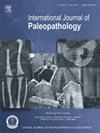Focus-stacked, ultra-macro photography: A tool for analysis, diagnosis and recording in bioarchaeology
IF 1.5
3区 地球科学
Q3 PALEONTOLOGY
引用次数: 0
Abstract
Objective
This study assesses the potential role of focus-stacked, ultra-macro photography in the differential diagnosis of pathological conditions in human skeletal remains.
Materials
1. A segment of calcified artery from the remains of a medieval cleric from Staffordshire, UK. 2. The skeletal remains of an eight-year-old child with active rickets from mid-19th century London. 3. Skeletal remains of a Romano-British neonate from Buckinghamshire, UK.
Methods
A microscope objective lens was attached, via an extension tube and relay lens, to a digital camera on a motorised focus-stacking rail. Photographs of skeletal elements and calcified arteries were taken at progressively close focal distance, and processed digitally to generate a single, fully focused image.
Results
On-screen magnification of up to ∼Χ1000 is achievable, permitting visualisation of bone modelling units (osteoclastic pits) and osteonal lamellae. The highly magnified images of skeletal remains reveal physiological and pathological changes which are undetectable with conventional macroscopic examination.
Conclusion
Ultra-macro photography facilitates the biological model of differential diagnosis in bioarchaeology and contributes to revised interpretation.
Significance
Focus-stacked photography, using microscope objective lenses, is an inexpensive and practical method for detecting, analysing and recording physiological and pathological change in skeletal remains.
Limitations
Images from only three individuals were evaluated in this study.
Suggestions for further research
Further studies are needed to control for illumination, presentation of contour and accuracy of colour reproduction.
聚焦叠加、超微距摄影:生物考古学中分析、诊断和记录的工具
目的探讨聚焦叠加超显微摄影在人体骨骼病变鉴别诊断中的潜在作用。英国斯塔福德郡一位中世纪牧师遗骸上的一段钙化动脉。2. 19世纪中期的伦敦,一名患有活动性佝偻病的8岁儿童的骨骼残骸。英国白金汉郡罗马-英国新生儿的骨骼残骸。方法将显微镜物镜通过延长管和转接镜头连接到数码相机上,置于电动叠焦导轨上。骨骼元素和钙化动脉的照片是在逐渐接近焦距的情况下拍摄的,并经过数字处理,生成一个单一的、完全聚焦的图像。结果可实现高达Χ1000的屏幕放大,允许可视化骨模型单元(破骨窝)和骨片层。高度放大的骨骼图像显示了常规宏观检查无法检测到的生理和病理变化。结论微距摄影有助于生物考古鉴别诊断的生物学模型,有助于修订解释。利用显微镜物镜进行叠焦摄影,是一种廉价、实用的检测、分析和记录遗骸生理和病理变化的方法。局限性:本研究仅评估了三个个体的图像。对进一步研究的建议:需要进一步研究照明控制、轮廓呈现和色彩再现的准确性。
本文章由计算机程序翻译,如有差异,请以英文原文为准。
求助全文
约1分钟内获得全文
求助全文
来源期刊

International Journal of Paleopathology
PALEONTOLOGY-PATHOLOGY
CiteScore
2.90
自引率
25.00%
发文量
43
期刊介绍:
Paleopathology is the study and application of methods and techniques for investigating diseases and related conditions from skeletal and soft tissue remains. The International Journal of Paleopathology (IJPP) will publish original and significant articles on human and animal (including hominids) disease, based upon the study of physical remains, including osseous, dental, and preserved soft tissues at a range of methodological levels, from direct observation to molecular, chemical, histological and radiographic analysis. Discussion of ways in which these methods can be applied to the reconstruction of health, disease and life histories in the past is central to the discipline, so the journal would also encourage papers covering interpretive and theoretical issues, and those that place the study of disease at the centre of a bioarchaeological or biocultural approach. Papers dealing with historical evidence relating to disease in the past (rather than history of medicine) will also be published. The journal will also accept significant studies that applied previously developed techniques to new materials, setting the research in the context of current debates on past human and animal health.
 求助内容:
求助内容: 应助结果提醒方式:
应助结果提醒方式:


